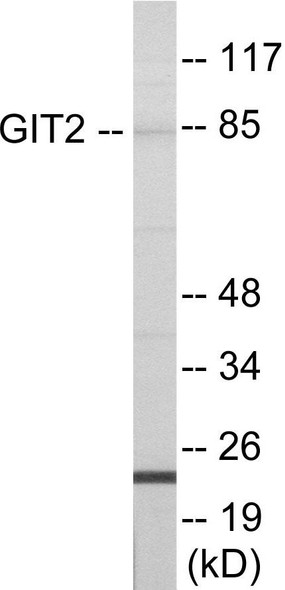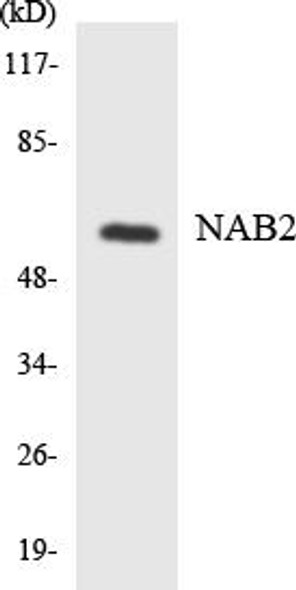Description
| Product Name: | AKAP13 Colorimetric Cell-Based ELISA |
| Product Code: | CBCAB01074 |
| ELISA Type: | Cell-Based |
| Target: | AKAP13 |
| Reactivity: | Human |
| Dynamic Range: | > 5000 Cells |
| Detection Method: | Colorimetric 450 nmStorage/Stability:4°C/6 Months |
| Format: | 96-Well Microplate |
The AKAP13 Colorimetric Cell-Based ELISA Kit is a convenient, lysate-free, high throughput and sensitive assay kit that can detect AKAP13 protein expression profile in cells. The kit can be used for measuring the relative amounts of AKAP13 in cultured cells as well as screening for the effects that various treatments, inhibitors (ie siRNA or chemicals), or activators have on AKAP13.
Qualitative determination of AKAP13 concentration is achieved by an indirect ELISA format. In essence, AKAP13 is captured by AKAP13-specific primary antibodies while the HRP-conjugated secondary antibodies bind the Fc region of the primary antibody. Through this binding, the HRP enzyme conjugated to the secondary antibody can catalyze a colorimetric reaction upon substrate addition. Due to the qualitative nature of the Cell-Based ELISA, multiple normalization methods are needed:
| 1. | A monoclonal antibody specific for human GAPDH is included to serve as an internal positive control in normalizing the target absorbance values. |
| 2. | Following the colorimetric measurement of HRP activity via substrate addition, the Crystal Violet whole-cell staining method may be used to determine cell density. After staining, the results can be analysed by normalizing the absorbance values to cell amounts, by which the plating difference can be adjusted. |
| Database Information: | Gene ID: 11214, UniProt ID: Q12802, OMIM: 604686, Unigene: Hs.459211/Hs.710656 |
| Gene Symbol: | AKAP13 |
| Sub Type: | None |
| UniProt Protein Function: | AKAP13: Anchors cAMP-dependent protein kinase (PKA) and acts as an adapter protein to selectively couple G alpha-13 and Rho. Augments gene activation by the estrogen receptor in an element- specific and ligand-dependent manner. Activates estrogen receptor beta by a p38 MAPK-dependent pathway. Stimulates exchange activity on Rho proteins in vitro, but not on CDC42, Ras or Rac and may bind calcium ions. 4 isoforms of the human protein are produced by alternative splicing. |
| UniProt Protein Details: | Protein type:GEFs; Nuclear export; Nuclear receptor co-regulator; GEFs, Rac/Rho; Adaptor/scaffold; Oncoprotein Chromosomal Location of Human Ortholog: 15q24-q25 Cellular Component: cell cortex; cortical actin cytoskeleton; cytoplasm; cytosol; membrane Molecular Function:guanyl-nucleotide exchange factor activity; MAP-kinase scaffold activity; protein binding; protein complex scaffold; protein kinase A binding; Rho GTPase binding; Rho guanyl-nucleotide exchange factor activity; signal transducer activity Biological Process: cardiac muscle cell differentiation; G-protein coupled receptor protein signaling pathway; heart development; positive regulation of apoptosis; positive regulation of I-kappaB kinase/NF-kappaB cascade; positive regulation of Rho protein signal transduction; regulation of small GTPase mediated signal transduction |
| NCBI Summary: | The A-kinase anchor proteins (AKAPs) are a group of structurally diverse proteins which have the common function of binding to the regulatory subunit of protein kinase A (PKA) and confining the holoenzyme to discrete locations within the cell. This gene encodes a member of the AKAP family. Alternative splicing of this gene results in multiple transcript variants encoding different isoforms containing c-terminal dbl oncogene homology (DH) and pleckstrin homology (PH) domains. The DH domain is associated with guanine nucleotide exchange activation for the Rho/Rac family of small GTP binding proteins, resulting in the conversion of the inactive GTPase to the active form capable of transducing signals. The PH domain has multiple functions. Therefore, these isoforms function as scaffolding proteins to coordinate a Rho signaling pathway, function as protein kinase A-anchoring proteins and, in addition, enhance ligand-dependent activity of estrogen receptors alpha and beta. [provided by RefSeq, Jul 2012] |
| UniProt Code: | Q12802 |
| NCBI GenInfo Identifier: | 134048676 |
| NCBI Gene ID: | 11214 |
| NCBI Accession: | Q12802.2 |
| UniProt Secondary Accession: | Q12802,Q14572, Q59FP6, Q86W90, Q8WXQ6, Q96JP6, Q96P79 Q9Y5T0, Q9Y5T6, |
| UniProt Related Accession: | Q12802 |
| Molecular Weight: | 307550 Da |
| NCBI Full Name: | A-kinase anchor protein 13 |
| NCBI Synonym Full Names: | A-kinase anchoring protein 13 |
| NCBI Official Symbol: | AKAP13 |
| NCBI Official Synonym Symbols: | BRX; LBC; p47; HA-3; Ht31; c-lbc; PRKA13; AKAP-13; AKAP-Lbc; ARHGEF13; PROTO-LB; PROTO-LBC |
| NCBI Protein Information: | A-kinase anchor protein 13 |
| UniProt Protein Name: | A-kinase anchor protein 13 |
| UniProt Synonym Protein Names: | AKAP-Lbc |
| Protein Family: | A-kinase anchor protein |
| UniProt Gene Name: | AKAP13 |
| UniProt Entry Name: | AKP13_HUMAN |
| Component | Quantity |
| 96-Well Cell Culture Clear-Bottom Microplate | 2 plates |
| 10X TBS | 24 mL |
| Quenching Buffer | 24 mL |
| Blocking Buffer | 50 mL |
| 15X Wash Buffer | 50 mL |
| Primary Antibody Diluent | 12 mL |
| 100x Anti-Phospho Target Antibody | 60 µL |
| 100x Anti-Target Antibody | 60 µL |
| Anti-GAPDH Antibody | 60 µL |
| HRP-Conjugated Anti-Rabbit IgG Antibody | 12 mL |
| HRP-Conjugated Anti-Mouse IgG Antibody | 12 mL |
| SDS Solution | 12 mL |
| Stop Solution | 24 mL |
| Ready-to-Use Substrate | 12 mL |
| Crystal Violet Solution | 12 mL |
| Adhesive Plate Seals | 2 seals |
The following materials and/or equipment are NOT provided in this kit but are necessary to successfully conduct the experiment:
- Microplate reader able to measure absorbance at 450 nm and/or 595 nm for Crystal Violet Cell Staining (Optional)
- Micropipettes with capability of measuring volumes ranging from 1 µL to 1 ml
- 37% formaldehyde (Sigma Cat# F-8775) or formaldehyde from other sources
- Squirt bottle, manifold dispenser, multichannel pipette reservoir or automated microplate washer
- Graph paper or computer software capable of generating or displaying logarithmic functions
- Absorbent papers or vacuum aspirator
- Test tubes or microfuge tubes capable of storing ≥1 ml
- Poly-L-Lysine (Sigma Cat# P4832 for suspension cells)
- Orbital shaker (optional)
- Deionized or sterile water
*Note: Protocols are specific to each batch/lot. For the correct instructions please follow the protocol included in your kit.
| Step | Procedure |
| 1. | Seed 200 µL of 20,000 adherent cells in culture medium in each well of a 96-well plate. The plates included in the kit are sterile and treated for cell culture. For suspension cells and loosely attached cells, coat the plates with 100 µL of 10 µg/ml Poly-L-Lysine (not included) to each well of a 96-well plate for 30 minutes at 37°C prior to adding cells. |
| 2. | Incubate the cells for overnight at 37°C, 5% CO2. |
| 3. | Treat the cells as desired. |
| 4. | Remove the cell culture medium and rinse with 200 µL of 1x TBS, twice. |
| 5. | Fix the cells by incubating with 100 µL of Fixing Solution for 20 minutes at room temperature. The 4% formaldehyde is used for adherent cells and 8% formaldehyde is used for suspension cells and loosely attached cells. |
| 6. | Remove the Fixing Solution and wash the plate 3 times with 200 µL 1x Wash Buffer for five minutes each time with gentle shaking on the orbital shaker. The plate can be stored at 4°C for a week. |
| 7. | Add 100 µL of Quenching Buffer and incubate for 20 minutes at room temperature. |
| 8. | Wash the plate 3 times with 1x Wash Buffer for 5 minutes each time. |
| 9. | Add 200 µL of Blocking Buffer and incubate for 1 hour at room temperature. |
| 10. | Wash 3 times with 200 µL of 1x Wash Buffer for 5 minutes each time. |
| 11. | Add 50 µL of 1x primary antibodies (Anti-AKAP13 Antibody and/or Anti-GAPDH Antibody) to the corresponding wells, cover with Parafilm and incubate for 16 hours (overnight) at 4°C. If the target expression is known to be high, incubate for 2 hours at room temperature. |
| 12. | Wash 3 times with 200 µL of 1x Wash Buffer for 5 minutes each time. |
| 13. | Add 50 µL of 1x secondary antibodies (HRP-Conjugated AntiRabbit IgG Antibody or HRP-Conjugated Anti-Mouse IgG Antibody) to corresponding wells and incubate for 1.5 hours at room temperature. |
| 14. | Wash 3 times with 200 µL of 1x Wash Buffer for 5 minutes each time. |
| 15. | Add 50 µL of Ready-to-Use Substrate to each well and incubate for 30 minutes at room temperature in the dark. |
| 16. | Add 50 µL of Stop Solution to each well and read OD at 450 nm immediately using the microplate reader. |
(Additional Crystal Violet staining may be performed if desired – details of this may be found in the kit technical manual.)






